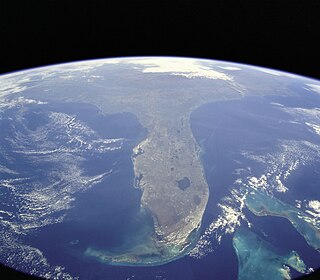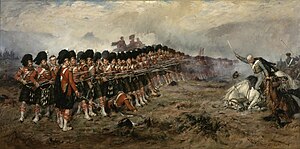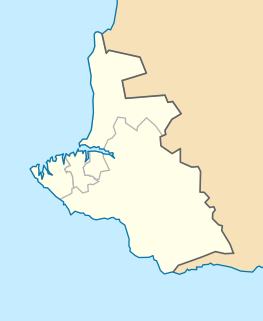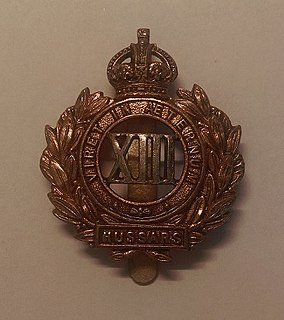This article needs additional citations for verification .(December 2011) (Learn how and when to remove this template message) |
Kadikoi (Crimean Tatar : Qadıköy, Russian : Кадыкой) in the 19th century was a village on the Crimean peninsula, in Ukraine, about one mile north of Balaklava. The Battle of Balaclava (also known as the Battle of Kadikoi to Russian historians) was fought on the hills and valleys to the north of Kadikoi in 1854. [1] The village was later known as Kadykovka (Кадыковка), and Pryhorodne (Пригородне). Currently it's merged into Balaklava city, and is known as microdistrict Kadykovka. Its original Crimean Tatar name means literally "village of a judge" (qadı - judge, köy - village).

Crimean Tatar, also called Crimean Turkic or simply Crimean, is a Kipchak Turkic language spoken in Crimea and the Crimean Tatar diasporas of Uzbekistan, Turkey, Romania and Bulgaria, as well as small communities in the United States and Canada. It should not be confused with Tatar proper, spoken in Tatarstan and adjacent regions in Russia; the languages are related, but belong to two different subgroups of the Kipchak languages and thus are not mutually intelligible. Crimean Tatar arrived in the 13th century with the Mongol Golden Horde, succeeding the Crimean Greek and Crimean Gothic Principality of Theodoro, and continued through the 15th–18th century Crimean Khanate period. Though only distantly related, it has been extensively influenced by nearby Oghuz Turkic languages such as Azerbaijani, Turkish and Turkmen.

Russian is an East Slavic language, which is official in the Russian Federation, Belarus, Kazakhstan and Kyrgyzstan, as well as being widely used throughout Eastern Europe, the Baltic states, the Caucasus and Central Asia. It was the de facto language of the Soviet Union until its dissolution on 25 December 1991. Although nearly three decades have passed since the breakup of the Soviet Union, Russian is used in official capacity or in public life in all the post-Soviet nation-states, as well as in Israel and Mongolia.

A peninsula is a landform surrounded by water on the majority of its border while being connected to a mainland from which it extends. The surrounding water is usually understood to be continuous, though not necessarily named as a single body of water. Peninsulas are not always named as such; one can also be a headland, cape, island promontory, bill, point, or spit. A point is generally considered a tapering piece of land projecting into a body of water that is less prominent than a cape. A river which courses through a very tight meander is also sometimes said to form a "peninsula" within the loop of water. In English, the plural versions of peninsula are peninsulas and, less commonly, peninsulae.

The British Army built a stationary engine on a hillside near the village, to up haul trains carrying men and materiel.

The British Army is the principal land warfare force of the United Kingdom, a part of British Armed Forces. As of 2018, the British Army comprises just over 81,500 trained regular (full-time) personnel and just over 27,000 trained reserve (part-time) personnel.

A stationary engine is an engine whose framework does not move. They are used to drive immobile equipment, such as pumps, generators, mills or factory machinery. The term usually refers to large immobile reciprocating engines, principally stationary steam engines and, to some extent, stationary internal combustion engines. Other large immobile power sources, such as steam turbines, gas turbines, and large electric motors, are categorized separately.

Materiel, refers to supplies, equipment, and weapons in military supply chain management, and typically supplies and equipment only in a commercial supply chain context.
Another hill, slightly to the north and east of Kadikoi, was defended by six companies of the 93rd (Highland) Regiment (the Sutherland Highlanders, around 600 soldiers), a Turkish battalion (around 1,000 soldiers), and a six-gun battery of field artillery. The hill was attacked by a large force of Russian cavalry on 25 October 1854, but repulsed by the British "Thin Red Line". The Heavy Brigade charged the stalled Russian cavalry in the South Valley slightly to the north, followed later by the charge of the Light Brigade in the North Valley, a few miles further north.

Turkey, officially the Republic of Turkey, is a transcontinental country located mainly in Western Asia, with a smaller portion on the Balkan Peninsula in Southeast Europe. East Thrace, located in Europe, is separated from Anatolia by the Sea of Marmara, the Bosphorous strait and the Dardanelles. Turkey is bordered by Greece and Bulgaria to its northwest; Georgia to its northeast; Armenia, the Azerbaijani exclave of Nakhchivan and Iran to the east; and Iraq and Syria to the south. Istanbul is the largest city, but more central Ankara is the capital. Approximately 70 to 80 per cent of the country's citizens identify as Turkish. Kurds are the largest minority; the size of the Kurdish population is a subject of dispute with estimates placing the figure at anywhere from 12 to 25 per cent of the population.

The Charge of the Light Brigade was a charge of British light cavalry led by Lord Cardigan against Russian forces during the Battle of Balaclava on 25 October 1854 in the Crimean War. British commander Lord Raglan had intended to send the Light Brigade to prevent the Russians from removing captured guns from overrun Turkish positions, a task for which the light cavalry were well-suited. However, there was miscommunication in the chain of command, and the Light Brigade was instead sent on a frontal assault against a different artillery battery, one well-prepared with excellent fields of defensive fire. The Light Brigade reached the battery under withering direct fire and scattered some of the gunners, but they were forced to retreat immediately, and the assault ended with very high British casualties and no decisive gains.















